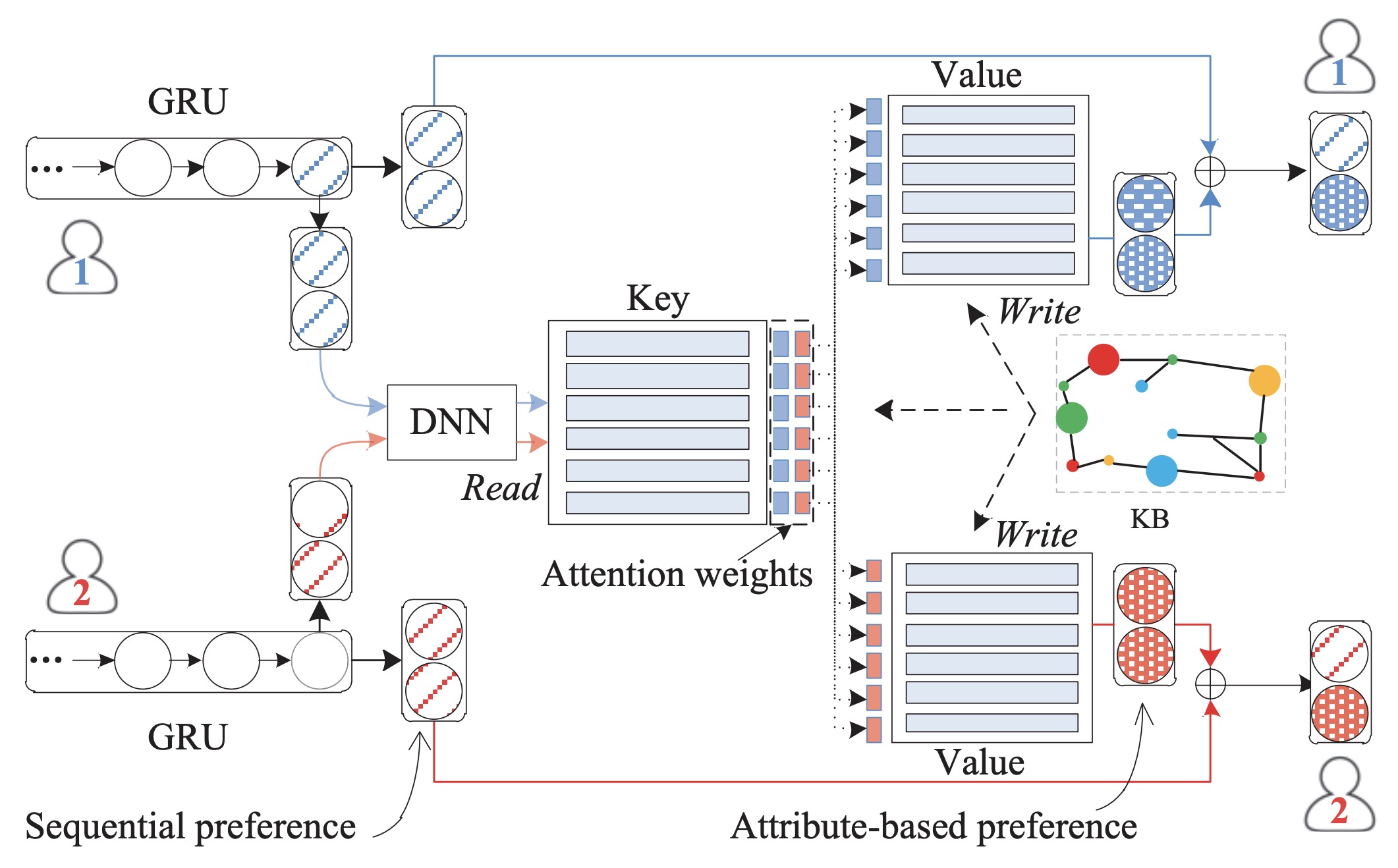KSR¶
Introduction¶
Title: Improving Sequential Recommendation with Knowledge-Enhanced Memory Networks
Authors: Jin Huang, Wayne Xin Zhao, Hongjian Dou, Ji-Rong Wen, Edward Y. Chang
Abstract: With the revival of neural networks, many studies try to adapt powerful sequential neural models, ıe Recurrent Neural Networks (RNN), to sequential recommendation. RNN-based networks encode historical interaction records into a hidden state vector. Although the state vector is able to encode sequential dependency, it still has limited representation power in capturing complicated user preference. It is difficult to capture fine-grained user preference from the interaction sequence. Furthermore, the latent vector representation is usually hard to understand and explain. To address these issues, in this paper, we propose a novel knowledge enhanced sequential recommender. Our model integrates the RNN-based networks with Key-Value Memory Network (KV-MN). We further incorporate knowledge base (KB) information to enhance the semantic representation of KV-MN. RNN-based models are good at capturing sequential user preference, while knowledge-enhanced KV-MNs are good at capturing attribute-level user preference. By using a hybrid of RNNs and KV-MNs, it is expected to be endowed with both benefits from these two components. The sequential preference representation together with the attribute-level preference representation are combined as the final representation of user preference. With the incorporation of KB information, our model is also highly interpretable. To our knowledge, it is the first time that sequential recommender is integrated with external memories by leveraging large-scale KB information.

Running with RecBole¶
Model Hyper-Parameters:
embedding_size (int): The embedding size of items and the KG feature. Defaults to64.hidden_size (int): The number of features in the hidden state. Defaults to128.num_layers (int): The number of layers in GRU. Defaults to1.dropout_prob (float): The dropout rate. Defaults to0.1.freeze_kg (bool): Whether to freeze the pre-trained knowledge embedding feature. Defaults toTrue.gamma (float): The scaling factor used to read operation when calculating the attention weights of user preference on attributes. Defaults to10.0.loss_type (str): The type of loss function. If it is set to'CE', the training task is regarded as a multi-classification task and the target item is the ground truth. In this way, negative sampling is not needed. If it is set to'BPR', the training task will be optimized in the pair-wise way, which maximizes the difference between the positive item and the negative one. In this way, negative sampling is necessary, such as setting--train_neg_sample_args="{'distribution': 'uniform', 'sample_num': 1}". Defaults to'CE'. Range in['BPR', 'CE'].
A Running Example:
Write the following code to a python file, such as run.py
from recbole.quick_start import run_recbole
parameter_dict = {
'train_neg_sample_args': None,
}
run_recbole(model='KSR', dataset='ml-100k', config_dict=parameter_dict)
And then:
python run.py
Notes:
If you want to run KSR, please prepare pretrained knowledge graph embedding and add the following settings to config files:
load_col: inter: [user_id, item_id] kg: [head_id, relation_id, tail_id] link: [item_id, entity_id] ent_feature: [ent_id, ent_vec] rel_feature: [rel_id, rel_vec] alias_of_entity_id: [ent_id] alias_of_relation_id: [rel_id] preload_weight: ent_id: ent_vec rel_id: rel_vec additional_feat_suffix: [ent_feature, rel_feature]
where the pretrained knowledge graph embedding should be stored in file named [dataset_name].ent_feature. If you want to add additional feature embedding, please refer to this example.
Tuning Hyper Parameters¶
If you want to use HyperTuning to tune hyper parameters of this model, you can copy the following settings and name it as hyper.test.
learning_rate choice [0.01,0.005,0.001,0.0005,0.0001]
dropout_prob choice [0.0,0.1,0.2,0.3,0.4,0.5]
num_layers choice [1,2,3]
hidden_size choice [128]
freeze_kg choice [True, False]
Note that we just provide these hyper parameter ranges for reference only, and we can not guarantee that they are the optimal range of this model.
Then, with the source code of RecBole (you can download it from GitHub), you can run the run_hyper.py to tuning:
python run_hyper.py --model=[model_name] --dataset=[dataset_name] --config_files=[config_files_path] --params_file=hyper.test
For more details about Parameter Tuning, refer to Parameter Tuning.
If you want to change parameters, dataset or evaluation settings, take a look at